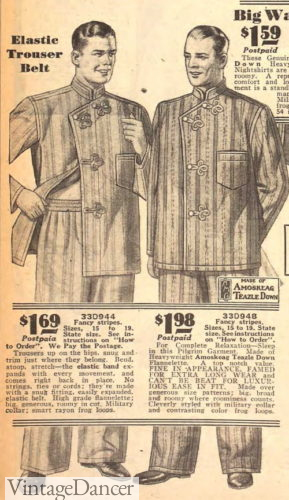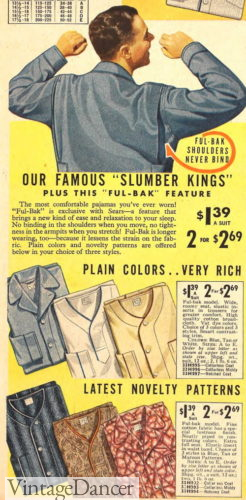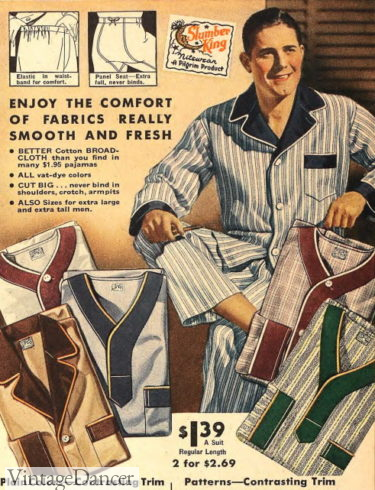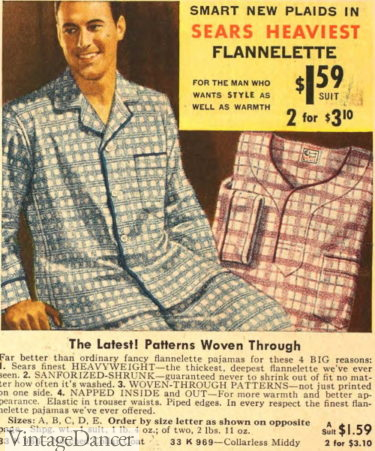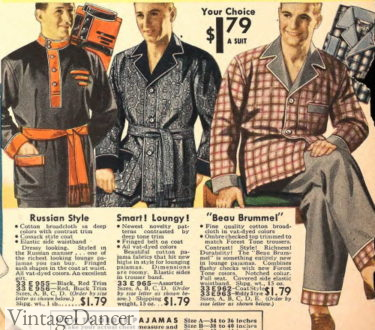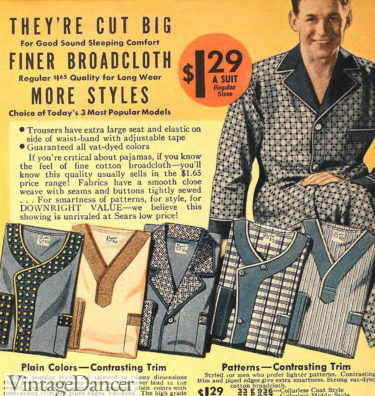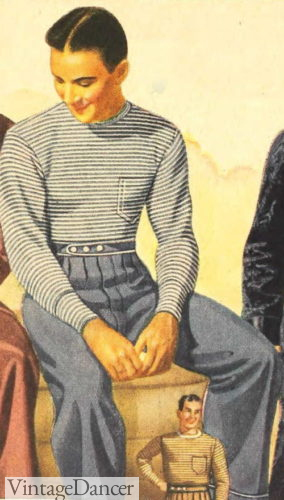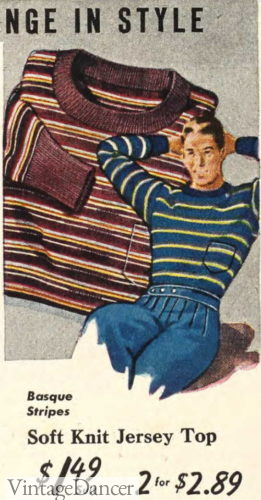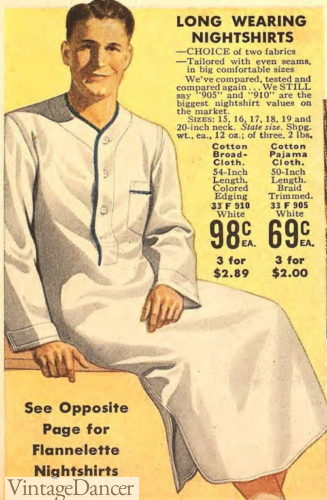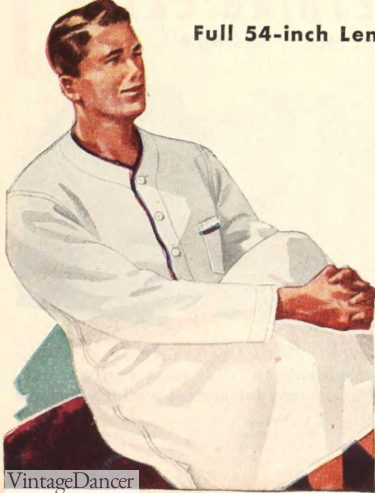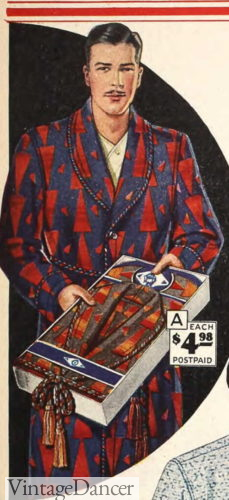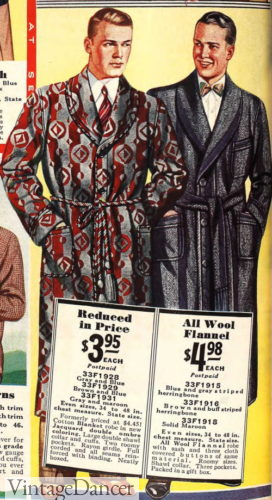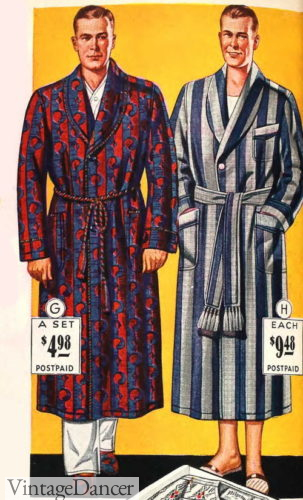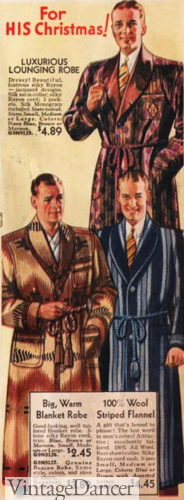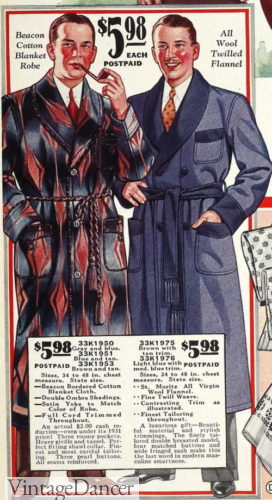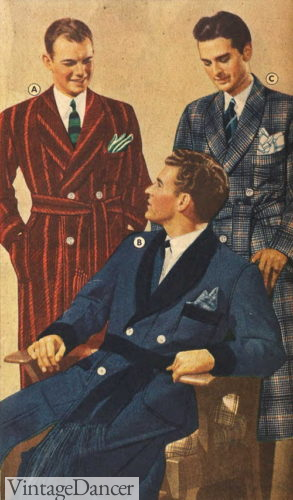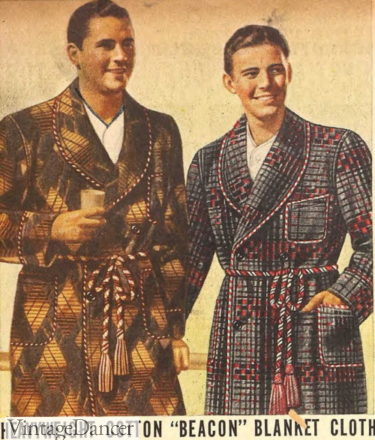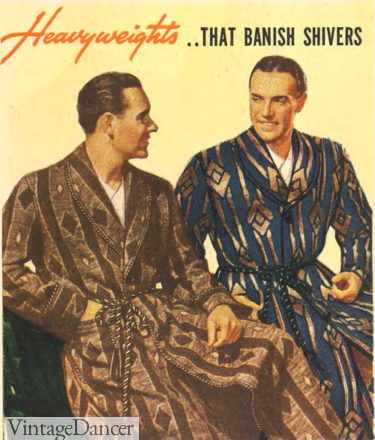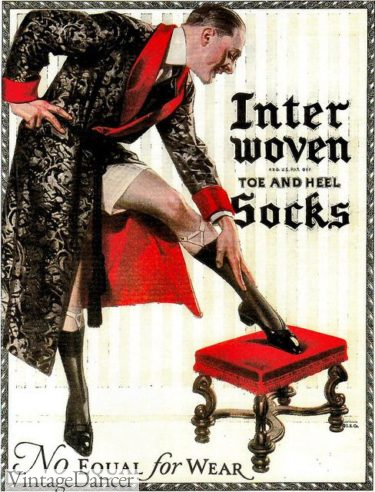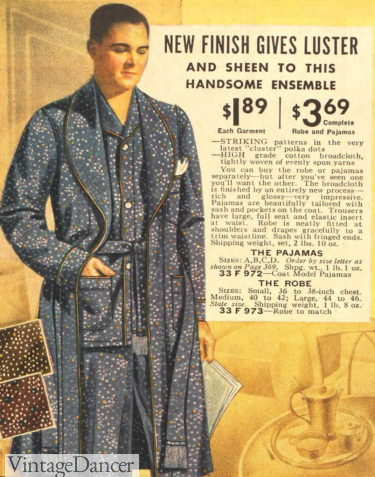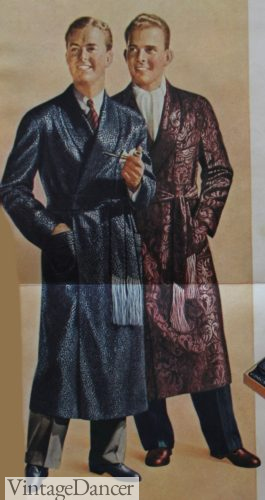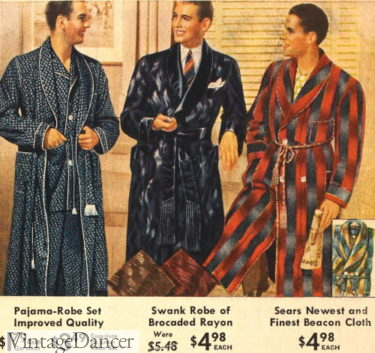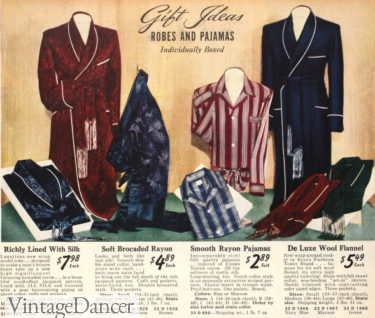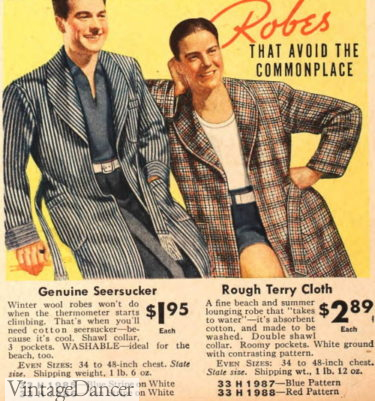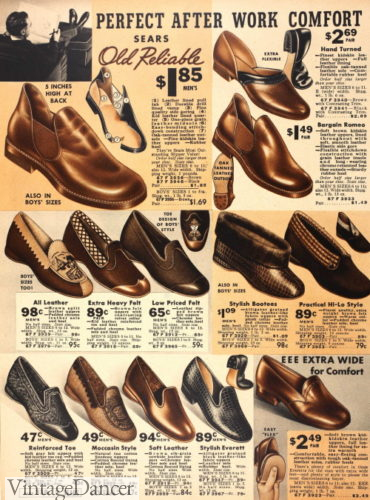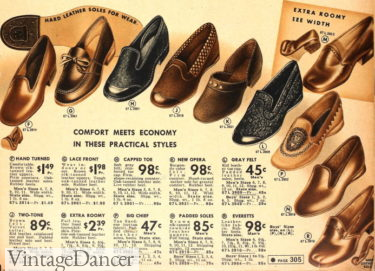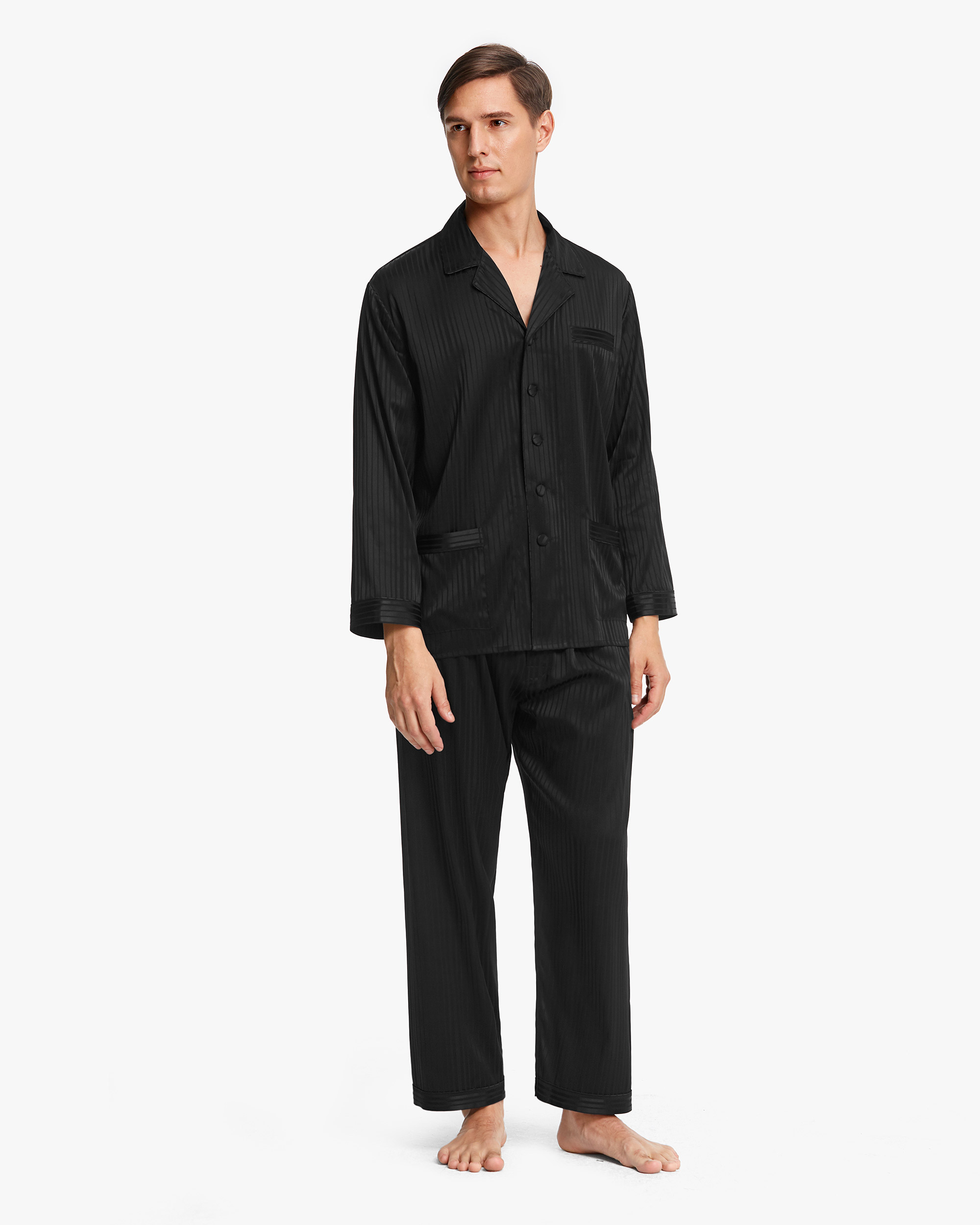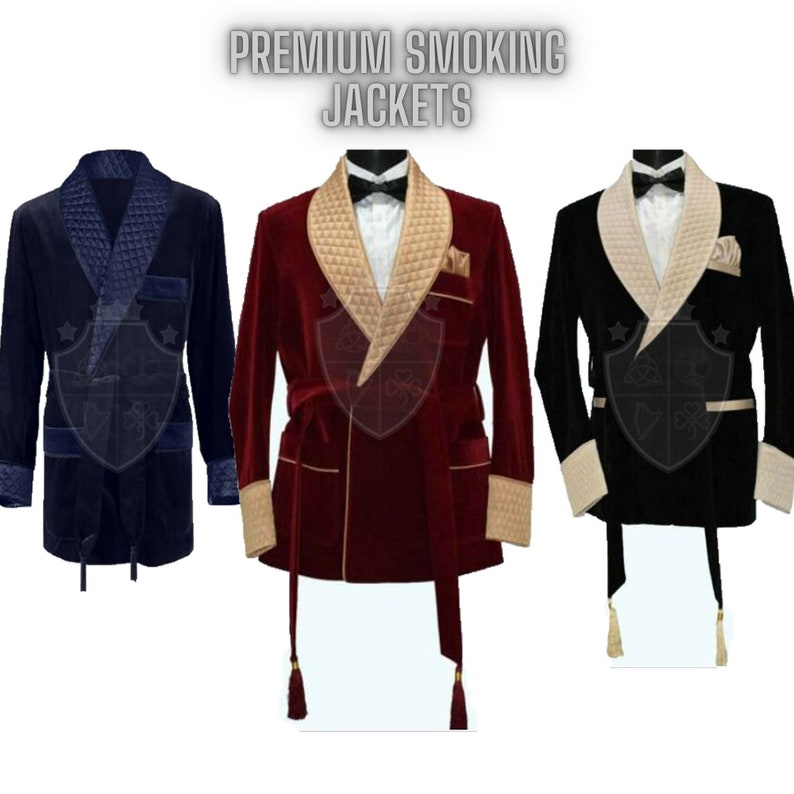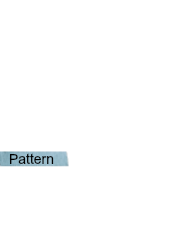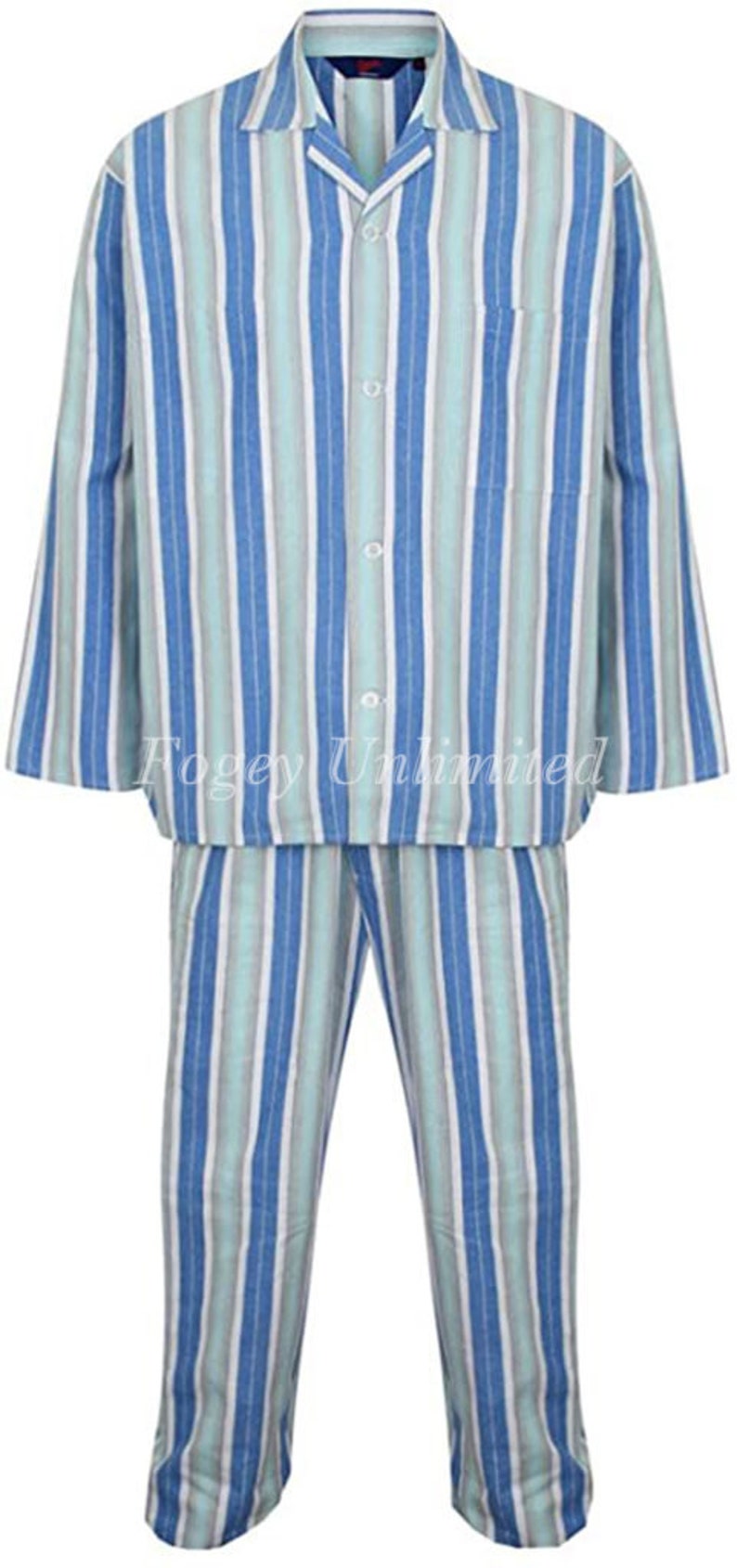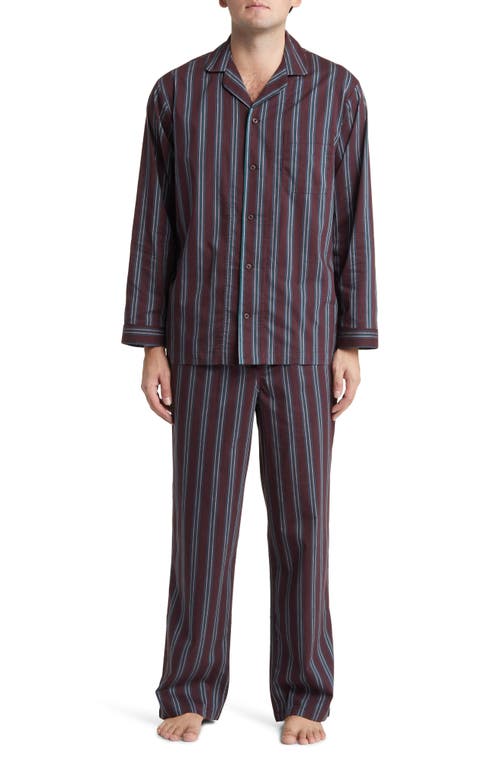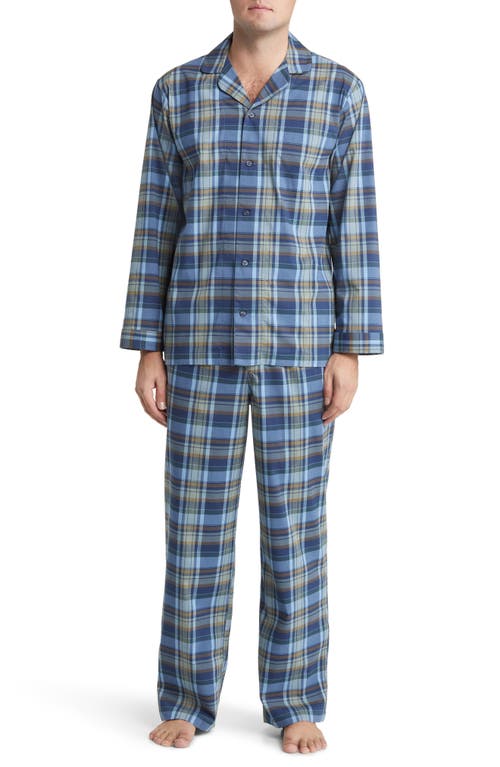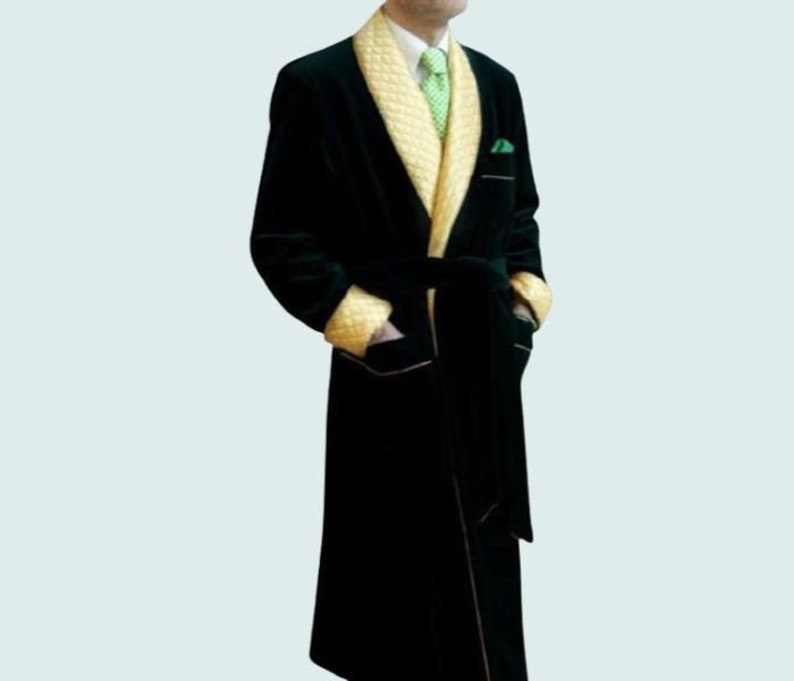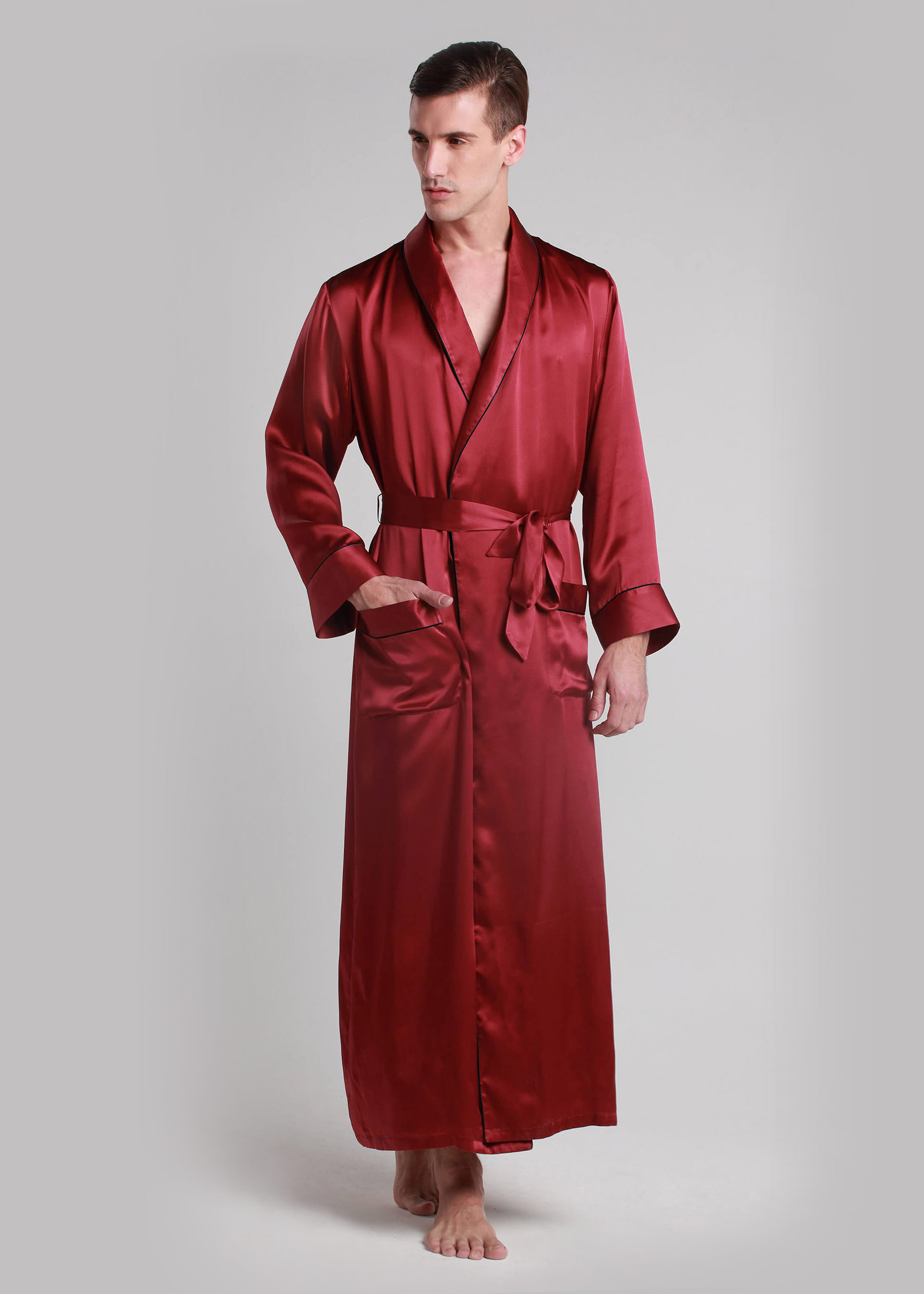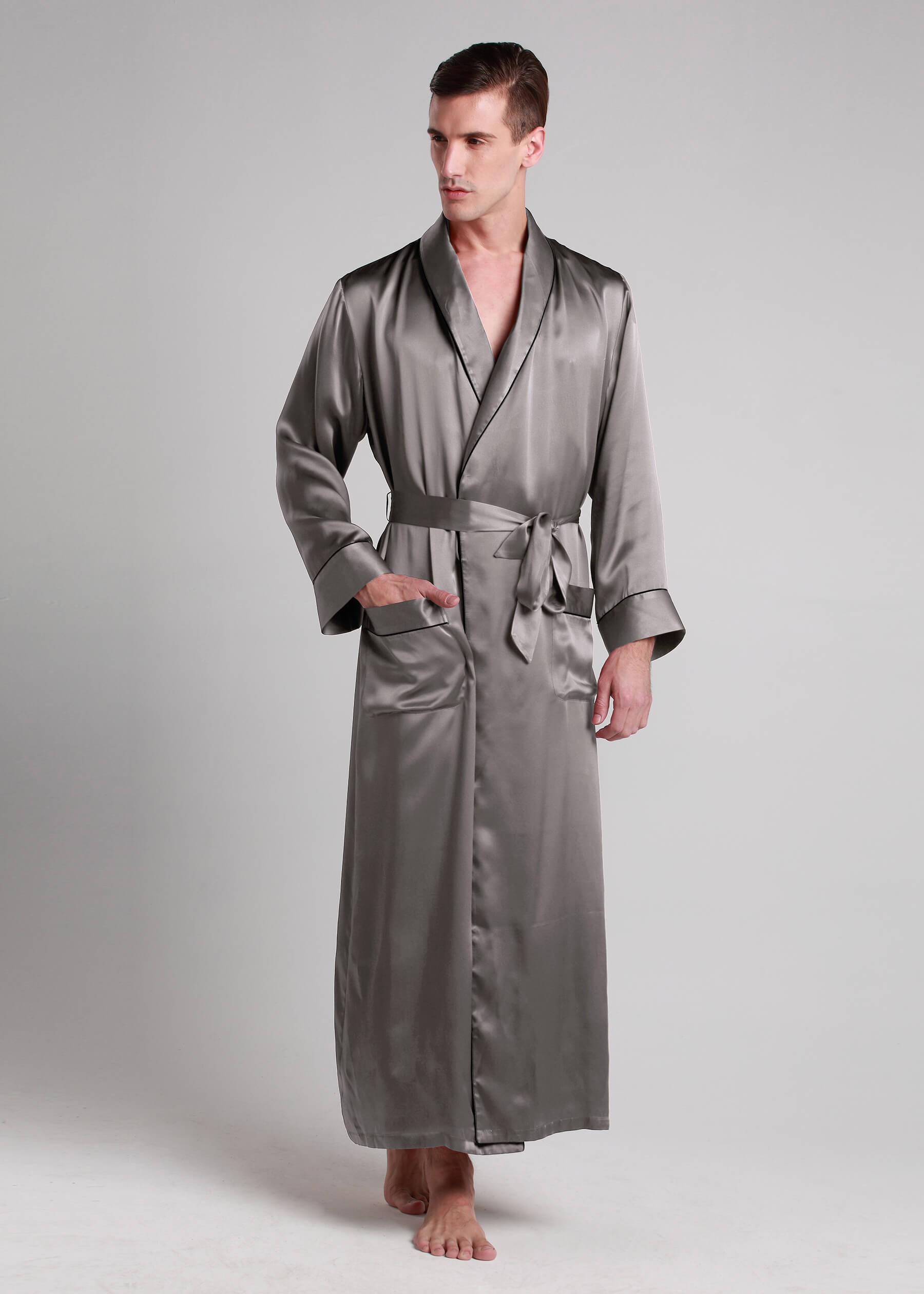In the 1930s, men’s sleepwear took style notes from the Far East. Asian frog clasps lined men’s pajamas shirts while the Russian style featured a sash belt.
“Americans going Russian to bed demand that their pajamas be Imperialistic.” – Men’s Wear, 1935
men’s 1930s pajamas / pyjamas overlapped with buttons to the side or shoulder. They had military collars, long button plaquettes, and double eagles embroidered on the chest pocket. They had a sash too, some with fringe tipped edges, in a contrasting color of shiny silk or satin. The sash proved to be problematic for sleeping comfortably, yet without it men’s evening appearance would not be regal enough.
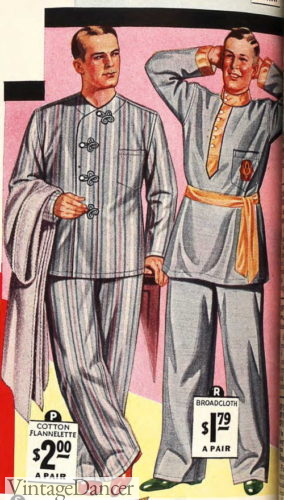
1931 Asian and Russian Style Pyjamas
Going with the manly-men theme, there were many more military inspired pajama designs with unique collars and plaquettes. “Musketeer” and “Grenadier” were a few of the names attached to these styles.
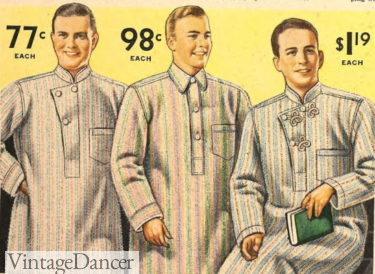
1936 Men’s Nightshirts with Military Details
There were of course, many carryover styles worn in the 1920s such as the basic V neck “Middy collar” pullover pajama or nightshirt. Solid colors and thick or thin stripes remained classic patterns too. Some stripe patterns were called Blazer stripes, awning stripes, multiple stripes, and ombre stripes.
There were also jacquard patterns with novelty designs of sports – races, golf, tennis, and swimming. Chinese imagery was also trending.
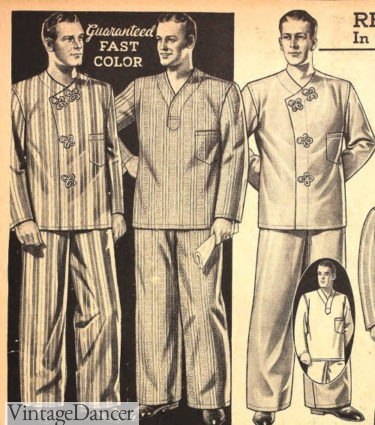
1934 Men’s Asian and V-Neck Pajama Styles
For comfort, designers added full buttoned pants with elastic waistbands, roomy seats, and large underarm bellows pleats.
- 1930 Men’s Pajama Pants had Elastic Waistbands
- 1938 Pleating Under Arms for Comfort
Pajama fabrics were mid-weight cotton or heavyweight wool flannel in winter. In spring and summer, it was cotton broadcloth that was both light and affordable. Voile was the lightest fabric reserved for wealthier classes. Advertisers said it was as light and sheer as a handkerchief. Linen-cotton blends, seersucker, and batiste were all breathable but thicker summer fabrics.
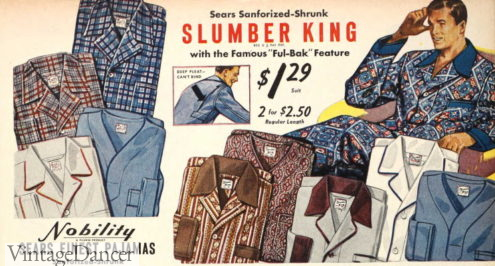
1939 Pajama Prints
For lounging, men may have chosen a silk, satin, rayon, or very fine gingham pajama. Colors spanned the seasons – light blues, yellow, tans and greens in spring and navy blue, wine red, chocolate brown, and black for winter.
Patterns for lounge suits (pajamas with a sash tie) explored bolder prints. Paisley, ocean waves, Grecian motifs, cathedral windows, Tartan plaid, and flowers were eye-candy for the ladies. Since women were the primary purchasers of men’s sleepwear, designers made sure to appeal to their tastes.
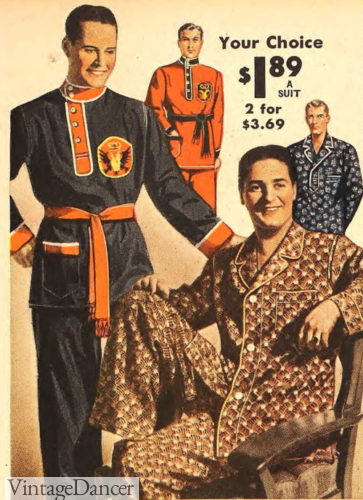
1937 Russian Cossack Style and Notch Lapel Lounge Pajamas
Notch Collar Pajamas
The newest design in men’s pajamas took inspiration from men’s sport collar shirts. The notch collar lapel pajamas were frequently worn in two-tone or two-pattern color combinations. Lapels were a solid color with contrast piping, while the body was a pattern of stripes, checks, plaid, medallion, or polka dots.
Occasionally, pajama pants matched the shirt collars instead of the shirt body. This was increasingly trendy going into the 1940s. Notch collar pajamas are the easiest to find among men’s classic pajamas sets.
- 1937 Two Tone Pajamas
- 1938 Plaid and Check Flannel Pajamas
- 1937 Russian and Notch Collar Pajamas
- 1937 Pajama Top Styles
Knit Pajamas
Sporty knit tops paired with woven cotton pants made up a small selection of men’s pajamas. They lacked the elegance of patterned pajamas, yet some men found them to be more casual and comfortable.
The horizontal striped knit top with high crew neckline and ribbed cuffs had a single chest pocket. Blue and wine red seemed to be the preferred colors. The pajama pants had a tab over button waistband with pleating and a long deep seat.
- 1937 Knit Pajama Top
- 1939 Striped Knit Shirt Pajamas
Nightshirts
Nightshirts or nightgowns were still being sold in the 1930s, although they were nothing special. Instead of stripes, plain white with colored piping trim was considered clean and classy in the 1930s.
- 1937 Nightshirts
- 1939 Nightshirt
1930s Men’s Robes
Striped flannel robes were bestsellers in the 1920s, but 1930s men turned to rich patterns or solid colors in wool flannel and terry cloth in winter, There were also cotton, linen, and silky textures for lounging in summer.
Flannel and blanket cloth or similar fabric made up the bulk of winter weight house robes. They tied with a rope or fringed sash. Patterns were often wide blazer stripes, ombre effect geometrics, brocade, plaid, or solids.
Both single breasted and the new double breasted robes were offered in the same patterns. All robes had large and long shawl collars with piped or rope trimmed edges.
- 1930 Geometric Arrows
- 1931 Ombre Geometrics
- 1931 Stripes and Geo
- 1933 Pattern or Stripes
- 1932 Geo or Solid
- 1938 Double Breasted
- 1938 Ombre Abstract or Plaid
- 1938 Brocade Look
For spring, summer, and house lounging with elegance, men’s robes embraced the same bold, geometric, and richly hued patterns but in lightweight luster tinted fabrics. Silk and rayon were the shiniest. Cotton and linen were the lightest — and were used as beach robes too.
- Silk Robe with Red Lapels
- 1937 Cotton Robe and Pajama Set
- 1938 Rayon Robes
- 1938 Rayon Robes
- 1939 Silk Lined Rayon and Wool Robes
- 1938 Cotton Beach Robes
1930s Smoking Jacket
The smoking jacket is trending again, creating demand for elegant vintage loungewear. The smoking jacket was a stiff velvet blazer style coat in the 1920s. This style lasted until the mid 1930s, but ultimately went out of favor. Men’s robes were now so elegant they simply didn’t need a separate smoking jacket too.
Some Hollywood stars wore short, hip length, shawl-collar robes with a tassel belt tie. These became the new Smoking jacket in the mid 1930s. Usually made of velvet, they could also be made of silk, brocade, or other luxurious fabrics.
You can find many smoking jackets on Etsy (both vintage and new). The newer styles tend to take style notes from other decades. For the 1930s, I would look for smooth lapels (not quilted) and a tassel belt. Pair with with a dress shirt, trousers, silk neck scarf, pipe, and slippers.
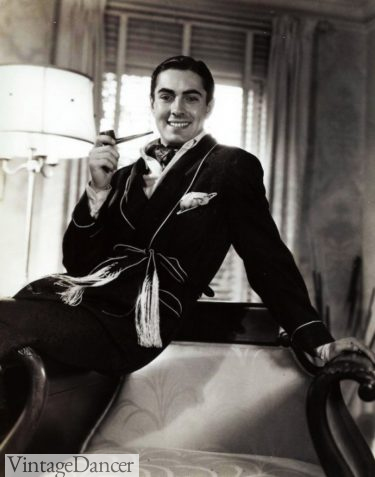
Tyrone Power
Men’s Slippers
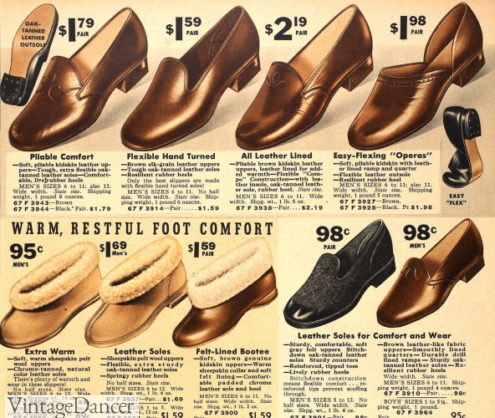
1937 men’s slippers
After a full day’s work, a man would slip off his Oxford shoes and put on a comfortable pair of house slippers. Most house slippers were slip on loafers with a plain body, high tongue, and low heel. Both the sole and heel were soft flexible leather. Felt bodies could also be used with a leather wingtip toe box.
The insole and lining was a cushioned quilted leather, fleece lining, or shearling.
Some men’s slipper varieties were:
- Romeo – Elastic side panel on a half boot. Consider old fashioned.
- Opera – Wide V notches on the sides – Also going out of style by the mid 1930s. The velvet or silk Opera slipper paired well with traditional smoking jackets.
- Everett – A plain slip on loafer. The majority of men’s slippers were these. Some had embroidery of sport or native American motifs on felt.
- Bootie – A bootie with fur, shearling or quilted flaps that fold up or down or complete a oval. Often sheepskin bodies.
- Moccasins – Native American moccasins in tan leather, with or without a bow.
- Huarache – Woven summer sandals made better house shoes in hot climate.
- 1937 Men’s Slippers
- 1939 Men’s Slippers
Shop 1930s Inspired Men’s Sleepwear and Longewear
Debbie Sessions has been teaching fashion history and helping people dress for vintage themed events since 2009. She has turned a hobby into VintageDancer.com with hundreds of well researched articles and hand picked links to vintage inspired clothing online. She aims to make dressing accurately (or not) an affordable option for all. Oh, and she dances too.
